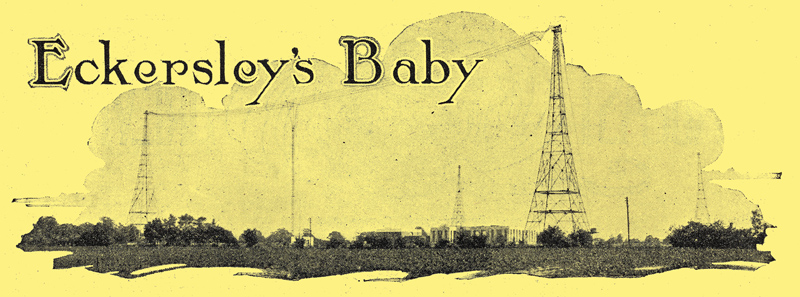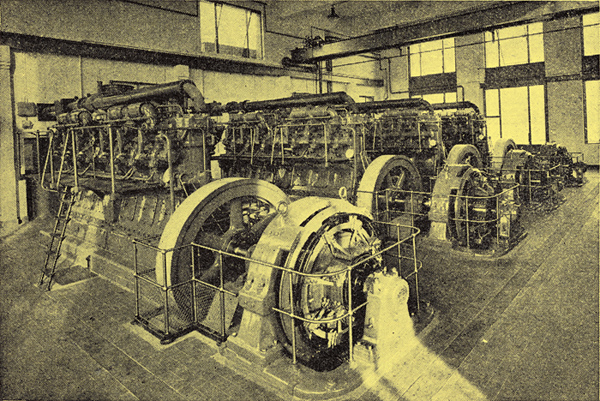|

A Visit to Brookman's Park BBC Regional Station.
The natal cry which shook the European ether and inaugurated the British regional scheme in the early hours of Monday last emanated from a station which, to judge from appearances, must mark anew standard of achievement in the annals of the BBC. To the eye of the visitor the Brookmans Park Twin Regional Station presents a spectacle of extraordinary symmetry, the almost severe buildings standing like a Druid circle in the centre of a small plateau and exactly midway between the two pairs of 200 foot lattice masts.
Entering the buildings at the east end, we find ourselves in the power house. Power is derived from Diesel generating plants. These machines, which run at 300 revolutions per minute, provide 300 hp, giving an output of 2,700 Amperes at 230 Volts. It is interesting to note that precautions have been taken to prevent the transmission of vibration to the valve equipment by mounting each of the generating plants on a concrete bed which is independent of the foundations of the building.
The use of a DC supply may be criticised, but its adoption makes possible the use of a floating accumulator battery capable of providing power to one transmitter in the event of engine failure.
Passing from the generator and battery rooms we find all the necessary machines for generating anode and filament current not only for the main transmitting valves, but for the auxiliary, oscillating and modulating equipment.
Progress in Generator Design

General view of the power house. A sound insulating channel surrounds the foundations of the machines.
A type of generator which marks progress in the design of machines of this class is in use, and is the product of the English Electrical Company. The armature is entirely insulated from its spindle, is built in two sections, and fitted with four commutators. By this means a potential of 12,000 Volts is obtainable from a single machine. There are three of these HT machines, each generating 160 kW and direct coupled to orthodox DC. motors driven from the motor generator sets already referred to.
As readers already know, the station is doubly equipped for the purpose of transmitting two programmes simultaneously on two wavelengths. Two of the three motor generators will thus be used together, the third being a spare for emergency use. Accommodated alongside the HT machines are three LT generators each with an output of 1,300 Amps. at voltages from 15 to 30. These machines, as well as those used for various anode voltages, grid biasing, etc., are in triplicate, so that in every case there is a stand-by generator.

One of the twin transmitters at Brookmans Park. On the extreme left are the drive oscillator and separator. Next is the modulating unit. This is followed by two banks of valves used for aerial excitation, and between them is the aerial tuning equipment, which connects through the feeders to the additional tuning inductances situated at the foot of the aerial and midway between the masts.
The main hall of the building is taken up with the transmitting equipment. Facing each other along the two sides are two identical transmitters each arranged to handle a separate programme through its own aerial system. The circuit adopted is similar to that employed at Daventry 5GB and consists of an oscillator (which can, if necessary, be fork controlled) which governs the lower power modulated oscillator through an intermediate tuned circuit called the separator. This arrangement prevents fluctuation of frequency within small limits.
The aerial is excited from two banks of eight water-cooled valves which are in opposite phase across the tuning inductance. A tuned feeder system couples the aerial with the transmitter, the necessary apparatus for tuning being housed in a small building immediately beneath the centre of the aerial.
A notable feature is the provision of means for switching over to a spare valve in all parts of the apparatus where a single valve is used, the breakdown of which would interrupt the working of the station. By merely turning a key switch the spare valve is thrown into circuit. Precautions have also been taken in connection with the paralleling of the main oscillating valves to prevent circulating currents, and by an arrangement of chokes each valve functions independently of its partners.
As already explained, modulation is at low power, i.e., the modulation is supplied to the intermediate oscillator. Each transmitter normally delivers 30 kW to its aerial. It is believed that almost full power is being used during the present tests, a small amount being kept in reserve.
Aerial Height Restrictions
The station is connected to Savoy Hill by underground cables. In the unlikely event of line failure, recourse can be had to wireless reception from Daventry, a special receiver being installed for this purpose.
It is unfortunate that the aerials are only 200 ft. high, but this is due to Government limitations on the height of masts which may be erected in the district. The earth systems, which radiate from the aerial tuning inductance houses, consist of a number of buried wires one foot below the surface of the ground and extending about 200 ft. to each side of the aerials.

This view, taken from the south-west, shows the extreme simplicity in the design of the station buildings.
|